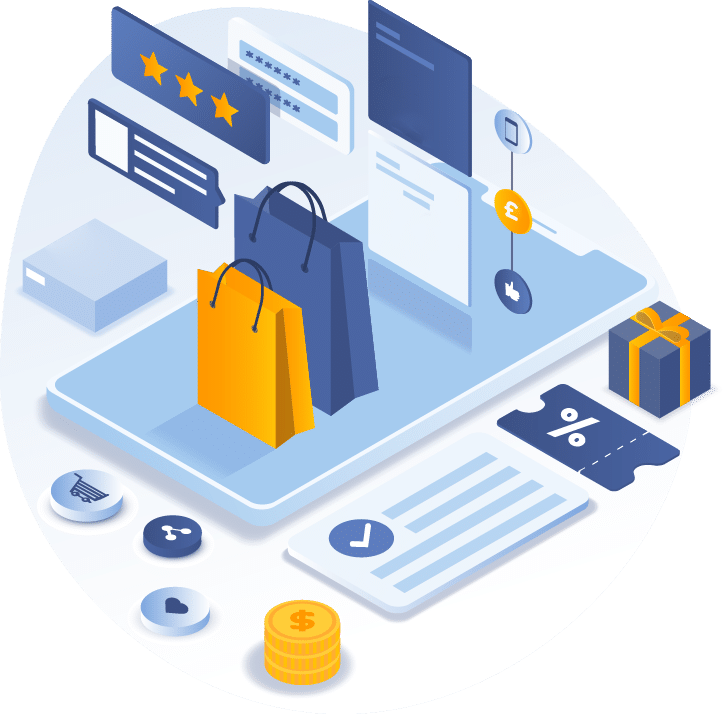As a result of the Pandemic, the Print Industry was forced into a dynamic evolution within the sphere of online retail. A new, inflated demand for ordering printed products online, saw an emergence of print businesses investing in print eCommerce software. Print eCommerce encapsulates a personalised and on-demand approach to consumer goods. It leverages cutting-edge digital printing technologies to create customised products after an order is placed by a customer. This innovative approach empowers consumers to tailor items to their unique preferences. The fusion of technology and individuality in print eCommerce not only transforms the way we shop but also heralds a new era where creativity and personal expression are at the forefront of the online shopping experience. Let’s take a closer look at the elements that help us explain what print eCommerce is.
The difference between traditional and print eCommerce
Print Ecommerce refers to the online retailing of customisable products that are designed and produced on-demand. Unlike traditional e-commerce models that rely on pre-manufactured inventory in which items are stored in warehouses awaiting purchase, print eCommerce thrives on creating unique and personalised items after an order is placed. This allows consumers to adapt a range of products to suit their requirements, whether a custom-designed t-shirt, a personalised mug, or even a bespoke piece of art.
Customisation at Your Fingertips
The beauty of print eCommerce lies in its ability to offer consumers a wide array of customisation options. From selecting colours, adding personalised text, uploading images, or choosing specific designs, customers can exercise their creativity to bring their vision to life. This level of personalisation not only enhances the emotional connection between the consumer and the product but also reflects the growing demand for unique, one-of-a-kind items.
How print on demand fits in
At the heart of print ecommerce is the print-on-demand model. As we previously discussed, traditional retail can be costly, wasteful, and lacks the flexibility to accommodate individual preferences. On the other hand, printing on demand allows for creating products in response to actual customer orders, eliminating the need for excess inventory and minimising environmental impact. Under the umbrella of print eCommerce lies two distinct models: Print on Demand (POD) fulfilment services and POD marketplaces. Each serve different purposes and cater to different needs which we explore below.
Business Model
POD Fulfilment Services
- Function: POD fulfilment services primarily cater to businesses and individuals who already have an established online presence, such as an eCommerce store.
- Role: These services handle the production, printing, and shipping of customised products on behalf of the seller.
- Integration: Sellers integrate the POD fulfilment service into their existing platforms, allowing for a seamless and branded customer experience.
POD Marketplaces
- Function: POD marketplaces serve as online platforms where designers and sellers can create and list their products for sale.
- Role: These platforms act as intermediaries, connecting sellers with consumers. They handle the storefront, product listing, and transaction processes.
- Audience: POD marketplaces often attract independent artists, designers, and entrepreneurs looking for a platform to showcase and sell their designs without the need for a standalone store.
Branding and Control
POD Fulfilment Services
- Branding Control: Sellers using POD fulfilment services typically have more control over their brand, as the customer interacts with their website and brand elements throughout the purchasing process.
- Customisation: Sellers can customise packaging and include promotional materials in shipments.
POD Marketplaces
- Branding Control: Sellers on POD marketplaces often operate within the marketplace’s framework, limiting the degree of customisation and branding they can apply to the overall shopping experience.
- Platform Guidelines: Sellers must adhere to the guidelines and policies set by the marketplace.
Product Range
POD Fulfilment Services
- Diverse Offerings: Sellers can offer a wide range of products beyond what a typical POD marketplace might offer, as they have control over their product catalogue.
POD Marketplaces
- Standardised Products: POD marketplaces may have a more standardised set of products, with a focus on popular items like T-shirts, hoodies, mugs, etc.
Pricing Structure
POD Fulfilment Services
- Pricing Control: Sellers have more control over pricing, determining their profit margins based on the cost of production and fulfilment.
POD Marketplaces
- Commission-Based: Many POD marketplaces operate on a commission-based model, where the platform takes a percentage of each sale in exchange for providing the storefront and audience.
Improvements in technology and software
The success of print ecommerce can largely be attributed to advancements in digital and web to print technologies. High-quality, cost-effective printing methods, such as direct-to-garment printing for apparel or digital printing for promotional items, have enabled businesses to produce intricate and vibrant designs on a variety of surfaces. This technological leap has made it possible for small businesses and independent artists to enter the market, contributing to the diversification of available products.
Flex4OPS – We deliver print eCommerce software solutions
Print eCommerce is not just a trend; it’s a dynamic shift in how we approach online shopping. At Flex4OPS, we have seen consumers continue to seek unique and sustainable products, maintaining the demand for print eCommerce. We supply our customers with flexible, scalable software solutions, aimed to help them meet the needs of this enduring trend. If you are looking for advice or information about how to develop your print business with print eCommerce, get in touch for a friendly chat and see how we could help you!
